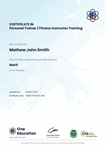Power Electronics for Electrical Engineering
Accredited by CPD | Complete Video Lessons from Expert Instructor | Tutor Support Included
One Education
Summary
- Exam(s) / assessment(s) is included in price
- Tutor is available to students
Add to basket or enquire
Overview
If you want to gain a solid understanding of Power Electronics for Electrical Engineering and fast track your dream career, then take a step in the right direction with this industry-standard, comprehensive course designed by expert instructors.
Dedicated tutor support and 24/7 customer support are available to all students with this ontext:premium quality course. Get the help you require and the answers to all your queries throughout the comprehensive syllabus of this course.
This premium online course titled Power Electronics for Electrical Engineering ensures your professional development with CPD accreditation. You’ll have the privilege of learning in your own time, at your own pace and earning an accredited certification.
With this Power Electronics for Electrical Engineering program, success becomes a lot easier that enables you to monetise your skills. This course is designed for both part-time and full-time students and can be completed at a pace that suits your learning style.
This Power Electronics for Electrical Engineering course is developed by industry experts and is packed with several insightful modules to give you a proper understanding of topics and allow you to accelerate your career.
Why People Love And Enrol The Power Electronics for Electrical Engineering Course From One Education
- Eligibility for a CPD -accredited certificate on successful completion of course
- Learning materials of our course contains engaging voiceover and visual elements for your comfort
- Freedom to study at your own pace
- 24/7 access to the course materials for 12 months
- Full Tutor support on weekdays (Monday – Friday)
CPD
Course media
Description
This masterclass Power Electronics for Electrical Engineering online training course is designed by industry experts and will give you an in-depth understanding of this topic. The course features easy-to-digest modules that break down each topic and ensure all our students receive an unrivalled and thorough learning experience.
If you want to work in this rapidly growing sector and stand out from the competition, then our Power Electronics for Electrical Engineering is the perfect place to kickstart your dream career.
On the course, we guarantee that you will gain relevant skills and acquire tremendous knowledge on the subject. The certificate you’ll achieve after completing the Power Electronics for Electrical Engineering course will help you land the job you want in a related field.
Enjoy a pleasant and professional 100% online learning experience and enrol in our course and take control of your career!
Course Curriculum:
Here is a curriculum breakdown of the course:
***Power Electronics for Electrical Engineering***
Unit 1- Introduction to Power Electronics Components
- Module 1- Introduction to Power Electronics
- Module 2- Uncontrolled Switches
- Module 3- What is the Benefit of Diode
- Module 4- Semi-Controlled Switches Part 1
- Module 5- Semi-Controlled Switches Part 2
- Module 6- Semi-Controlled Switches Part 3
- Module 7- What is the Benefit of Thyristor
- Module 8- Fully Controlled Switches Part 1
- Module 9- Fully Controlled Switches Part 2
- Module 10- Fully Controlled Switches Part 3
Unit 2- Fundamentals of Rectifier Circuits
- Module 1- Overview on Rectifiers
- Module 2- Rectifier Definition
- Module 3- Half Wave Uncontrolled Rectifier with R Load
- Module 4- Example on Half Wave Uncontrolled Rectifier with R Load Part 1
- Module 5- Example on Half Wave Uncontrolled Rectifier with R Load Part 2
- Module 6- Half Wave Uncontrolled Rectifier with RL Load
- Module 7- Derivation of the Discontinuous Current in R-L Load
- Module 8- Freewheeling Diode (Commutation Diode)
- Module 9- Half Wave R-L Load with FWD
- Module 10- Difference Between Continuous and Discontinuous Mode in RL Load
- Module 11- Half Wave RL Load with FWD Continuous Mode
- Module 12- Example on Half Wave Rectifier with FWD
- Module 13- Bridge Full Wave Uncontrolled Rectifier Part 1
- Module 14- Bridge Full Wave Uncontrolled Rectifier Part 2
- Module 15- Quick Revision on Bridge Full Wave Uncontrolled Rectifier
- Module 16- Firing Angle
- Module 17- Half Wave Controlled Rectifier R Load
- Module 18- Half Wave Controlled Rectifier R-L Load
- Module 19- Half Controlled R-L Load with FWD
- Module 20- Example 1
- Module 21- Example 2
- Module 22- Example 3
- Module 23- Example 4
- Module 24- Example 5
- Module 25- Fully Controlled Bridge Rectifier Part 1
- Module 26- Fully Controlled Bridge Rectifier Part 2
- Module 27- Quick Revision on Bridge Full Wave Controlled Rectifier
- Module 28- Example 6
- Module 29- Half Controlled Bridge Rectifier
- Module 30- Half Controlled Bridge Rectifier with FWD
- Module 31- Example 7
- Module 32- Example 8
- Module 33- Performance Parameters
- Module 34- Power Factor
Unit 3- Fundamentals of AC Choppers
- Module 1- Introduction to AC Choppers
- Module 2- Definition of AC Choppers
- Module 3- Switching Techniques in AC Choppers
- Module 4- Applications on AC Choppers
- Module 5- Types of AC Choppers
- Module 6- AC Chopper with R Load
- Module 7- Example 1 on AC Chopper with R Load
- Module 8- Example 2 on AC Chopper with R Load
- Module 9- AC Chopper with L Load Part 1
- Module 10- AC Chopper with L Load Part 2
- Module 11- Example on AC Chopper with L Load
- Module 12- AC Chopper with RL Series Load
- Module 13- Example on AC Chopper with RL Series Load
- Module 14- AC Chopper with RL Parallel Load
- Module 15- Example on AC Chopper with RL Parallel Load
- Module 16- AC Chopper with Pure Capacitive Load
- Module 17- Example on AC Chopper with Pure Capacitive Load
- Module 18- AC Chopper Loaded by Heavy Rectifier
- Module 19- AC Chopper Loaded by an AC Motor with Sinusoidal Back Emf
- Module 20- Example on AC Chopper Loaded by an AC Motor with Sinusoidal Back Emf
- Module 21- Integral Cycle Control
- Module 22- Example on Integral Cycle Control
Unit 4- Fundamentals of DC Choppers
- Module 1- Introduction to DC Choppers
- Module 2- Definition and Application of DC Choppers
- Module 3- Step down DC Chopper with R Load
- Module 4- Example on Step Dwon DC Chopper with R Load
- Module 5- Generation of Duty Cycle
- Module 6- Switching Techniques
- Module 7- Step Down DC Chopper with RLE Load Part 1
- Module 8- Step Down DC Chopper with RLE Load Part 2
- Module 9- Example 1 on Step Down DC Chopper with RLE Load
- Module 10- Example 2 on Step Down DC Chopper with RLE Load
- Module 11- Step Up DC Chopper with R or RL Load
- Module 12- Step Up DC Chopper with RE Load
- Module 13- Example on Step Up DC Chopper with RE Load
- Module 14- Buck Regulator Part 1
- Module 15- Buck Regulator Part 2
- Module 16- Example on Buck Regulator
- Module 17- Boost Regulator
- Module 18- Example on Boost Regulator
- Module 19- Buck Boost Converter
- Module 20- Example on Buck-Boost Converter
Unit 5- Fundamentals of Inverters
- Module 1- Introduction to Inverters
- Module 2- Definition of Inverters
- Module 3- Importance and Applications of Inverters
- Module 4- Single Phase Half Bridge R-Load
- Module 5- Single Phase Half Bridge RL- Load
- Module 6- Performance Parameters of an Inverter
- Module 7- Example on Single Phase Half Bridge
- Module 8- Single Phase Bridge Inverter R- Load
- Module 9- Single Phase Bridge Inverter RL- Load
- Module 10- Example on Single Phase Bridge Inverter
- Module 11- Three Phase Inverters and Obtaining the Line Voltages
- Module 12- Threee Phase Inverters and Obtaining The Phase Voltages
- Module 13- Example on Three Phase Inverters
- Module 14- Single Pulse Width Modulation
- Module 15- Multiple Pulse Width Modulation
- Module 16- Example on Multiple Pulse Width Modulation
- Module 17- Sinusoidal Pulse Width Modulation
- Module 18- Industrial Inverter
Exam & Retakes:
It is to inform our learners that the initial exam for this online course is provided at no additional cost. In the event of needing a retake, a nominal fee of £9.99 will be applicable.
Certification
Upon successful completion of the assessment procedure, learners can obtain their certification by placing an order and remitting a fee of £9 for PDF Certificate and £15 for the Hardcopy Certificate within the UK ( An additional £10 postal charge will be applicable for international delivery).
Who is this course for?
The Power Electronics for Electrical Engineering training course is ideal for highly motivated individuals who want to enhance their professional skills and train for the job they want! This course also suits people aspiring for some in-depth knowledge on this topic and keep up to date with the latest information.
Study the Power Electronics for Electrical Engineering course today and increase your professional skillset from the comfort of your home!
Requirements
There are no formal entry requirements for the course, with enrollment open to anyone! Anyone and everyone with a knack for learning can enrol this course without any hesitation.
Learn online from any internet device, including your computer, tablet or smartphone. Study when it suits you and complete the course at your own pace.
All students must have a passion for learning and literacy, as well as being over the age of 16.
Career path
Studying the course is designed to help you get the job of your dreams, or even that promotion you’ve been waiting for a long time. Learn the essential skills and knowledge you need to exceed in your professional life with the help & guidance from our course.
Questions and answers
Currently there are no Q&As for this course. Be the first to ask a question.
Reviews
Currently there are no reviews for this course. Be the first to leave a review.
Legal information
This course is advertised on reed.co.uk by the Course Provider, whose terms and conditions apply. Purchases are made directly from the Course Provider, and as such, content and materials are supplied by the Course Provider directly. Reed is acting as agent and not reseller in relation to this course. Reed's only responsibility is to facilitate your payment for the course. It is your responsibility to review and agree to the Course Provider's terms and conditions and satisfy yourself as to the suitability of the course you intend to purchase. Reed will not have any responsibility for the content of the course and/or associated materials.



